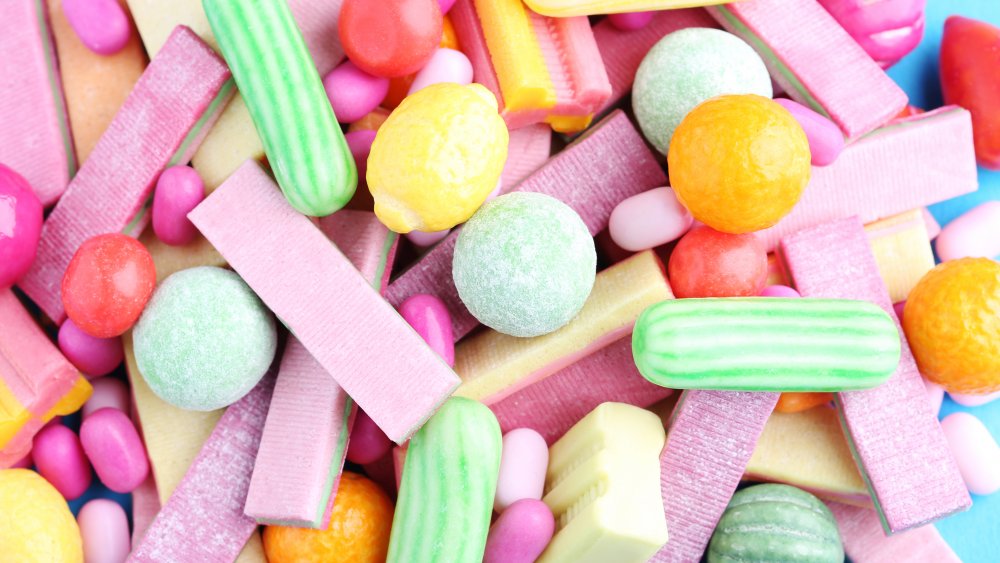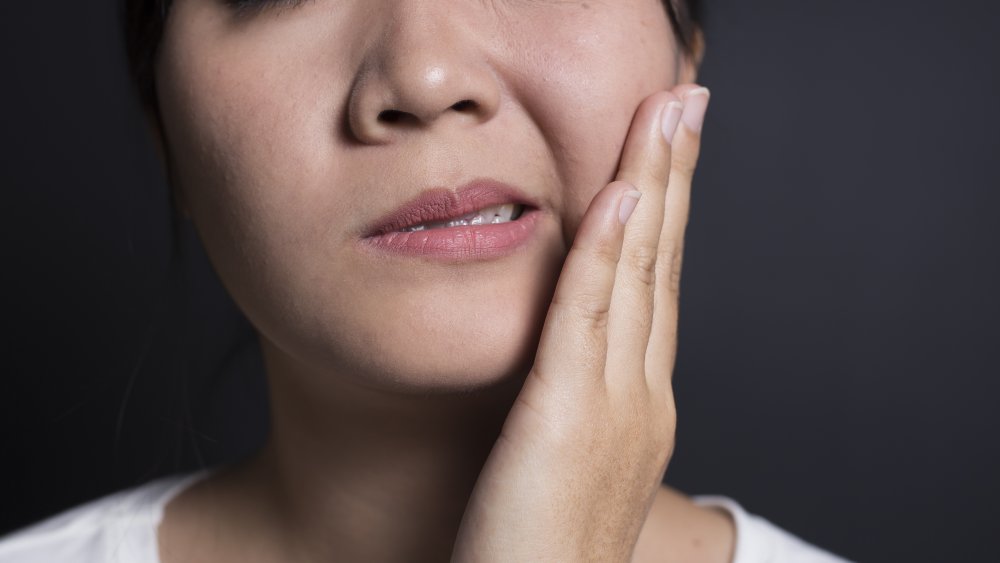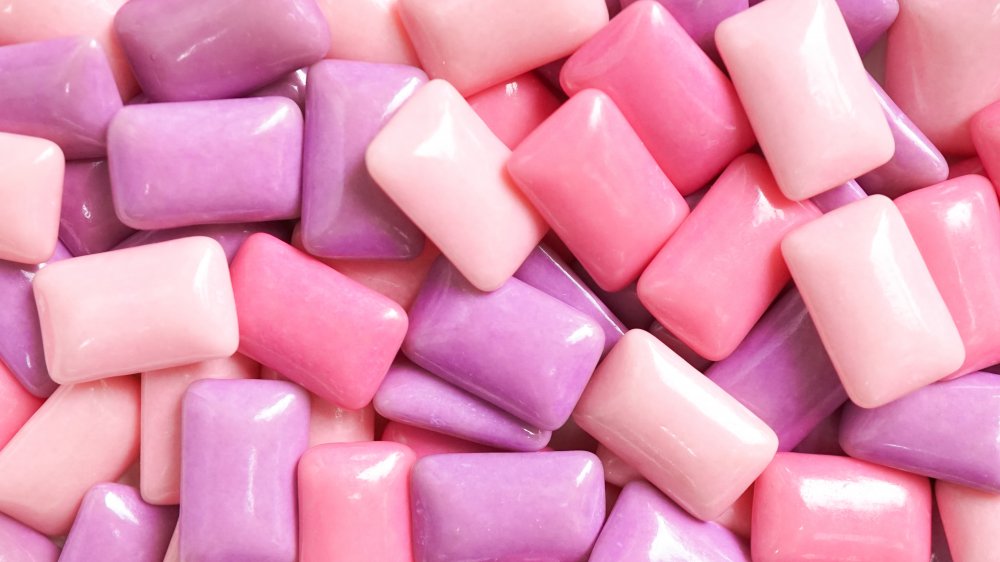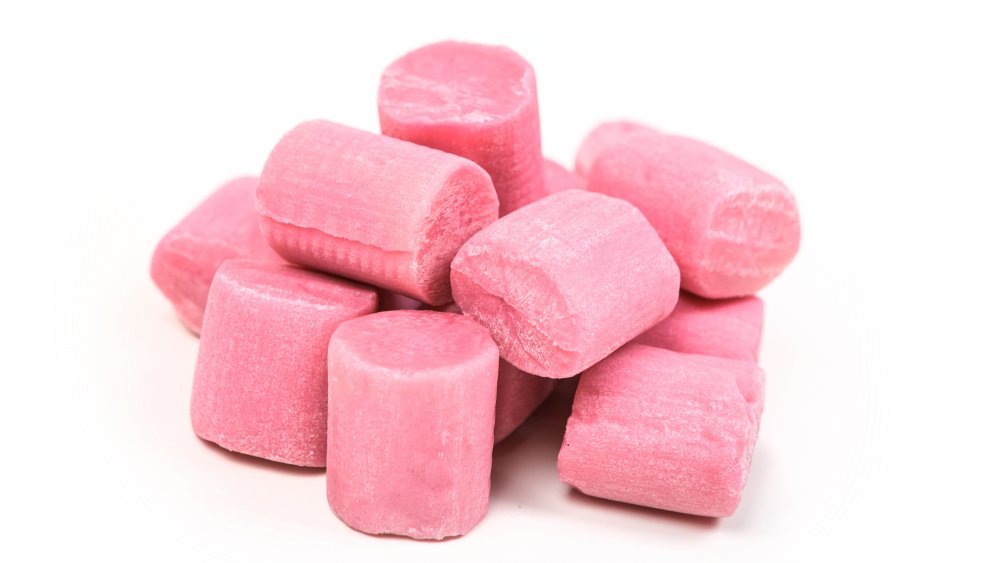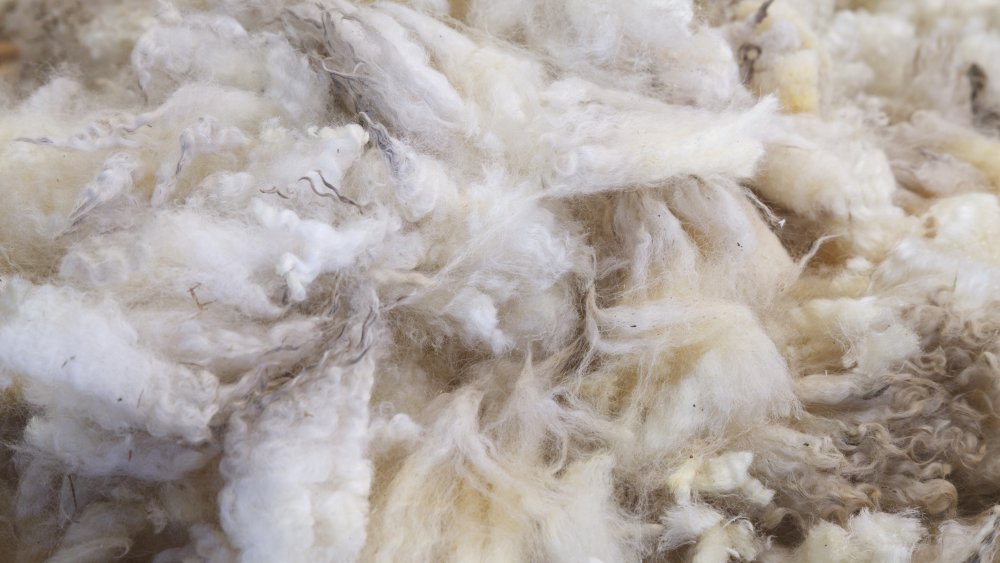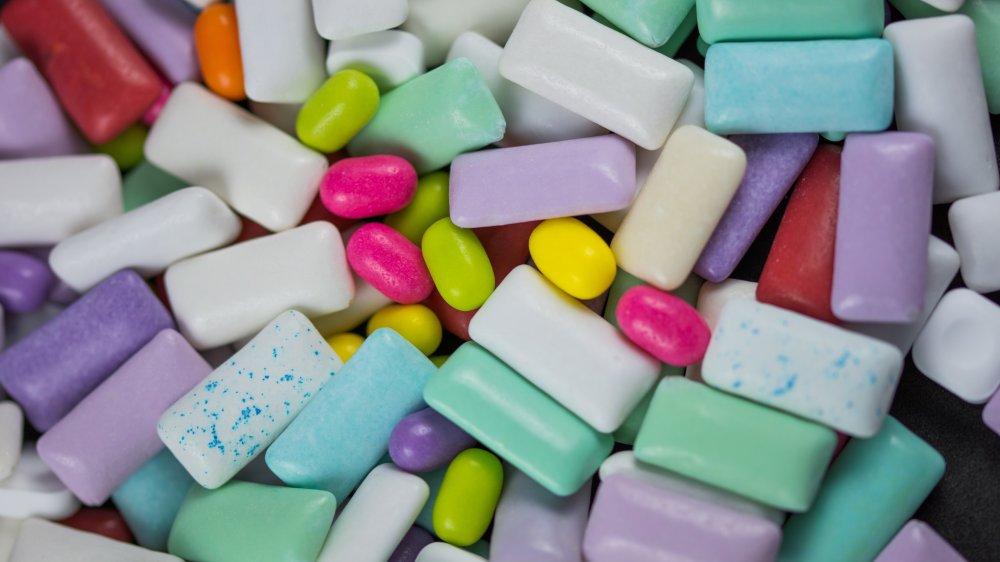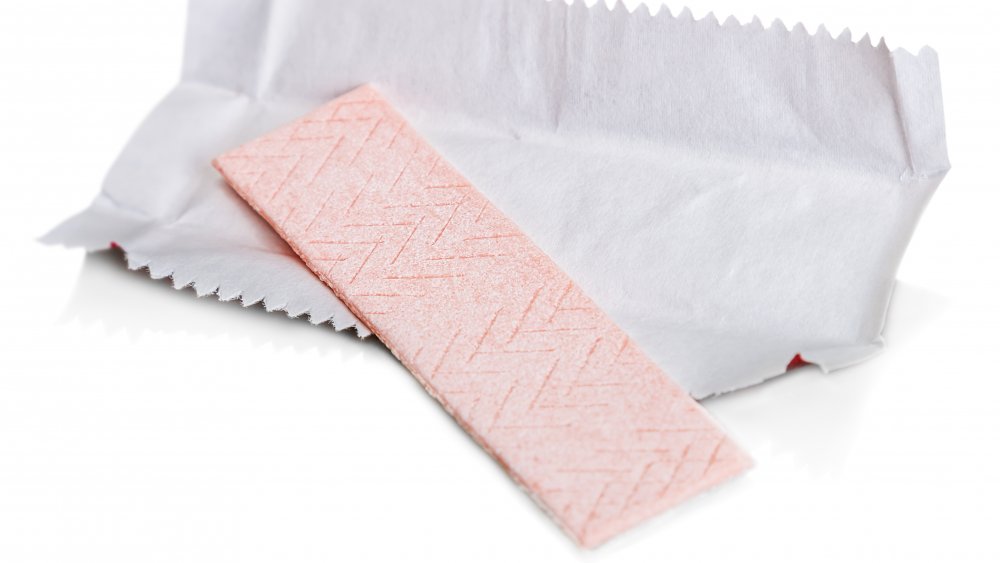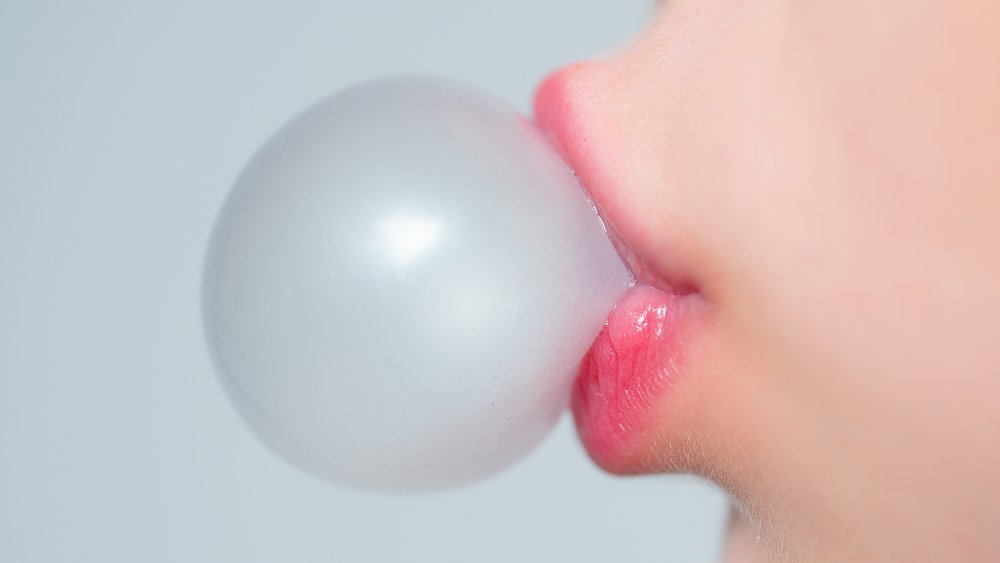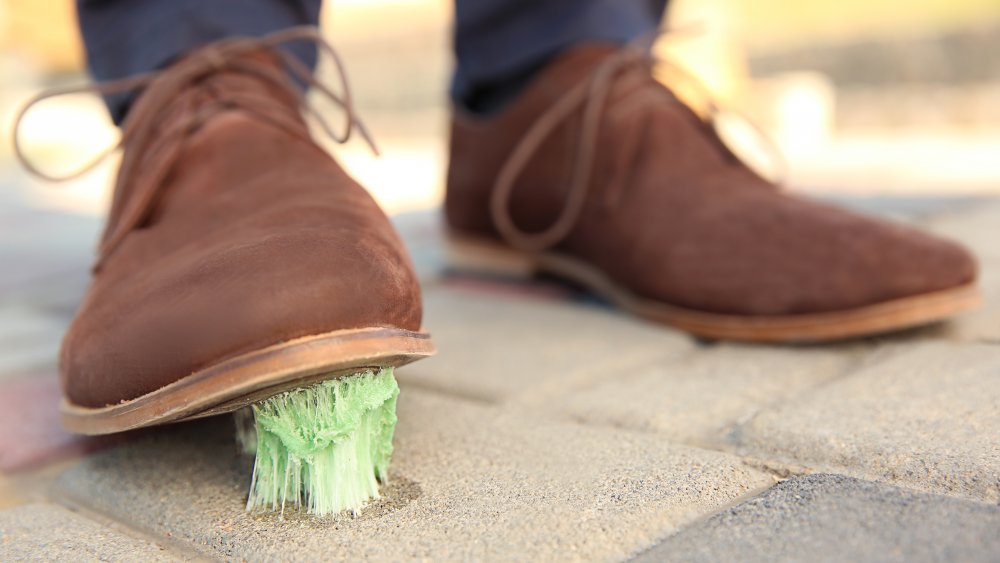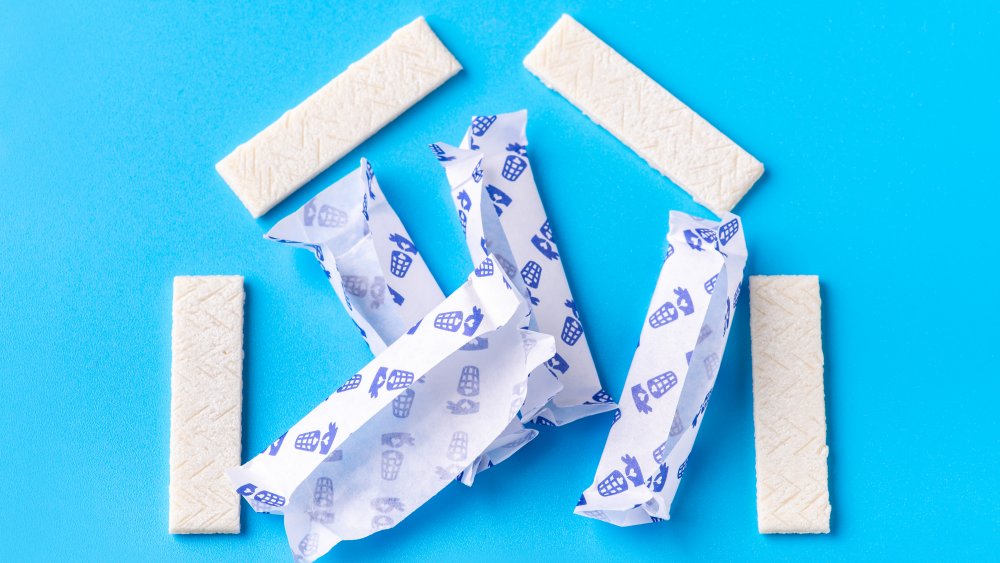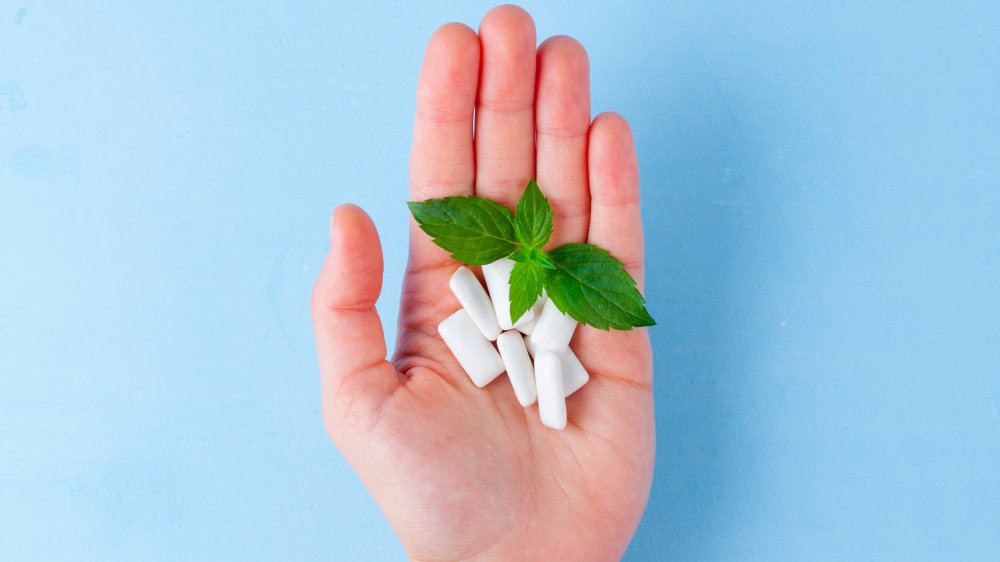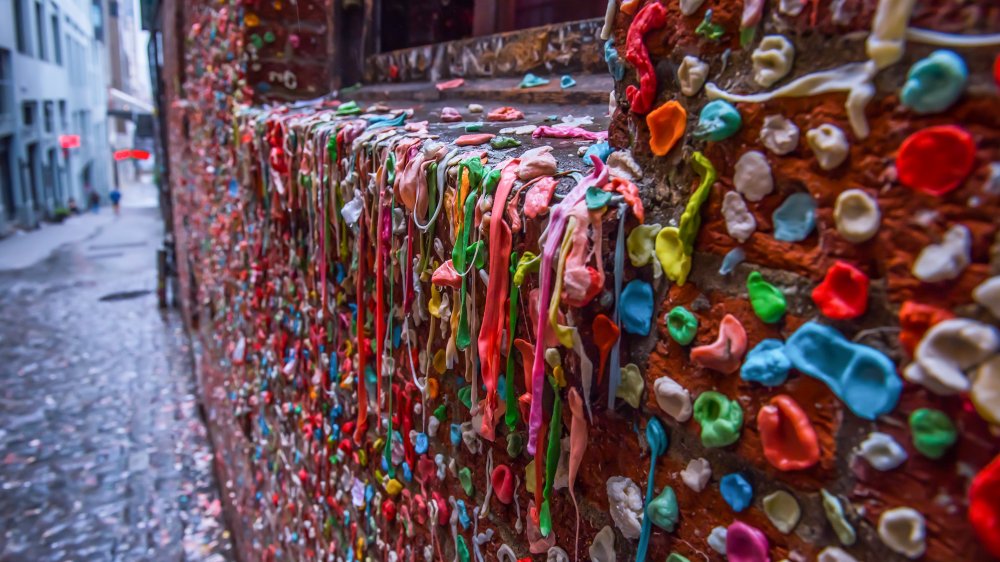What You Don't Want To Know About Bubble Gum
While it may seem like a relatively new invention, humans have been chewing gum for centuries, all the way back to when Europeans and North Americans chewed on the resin and bark of trees. Sounds delicious, right? We've certainly come a long way since then, but the method of chewing gum still remains the same.
With that long of a history, whether you've only tried it once or twice, or you chew gum every day, chances are, you've chewed a piece of gum before. From mint-flavored chews to big, bold fruity options, there's a huge number of gum options out there to suit any taste.
But what exactly are we doing when we chew bubble gum? And what about that myth of gum sitting in our stomach for seven years if we swallow it? Certainly, there must be more to bubble gum than meets the eye? Well, we decided to dig in to learn a bit more and as it turns out, bubble gum has a few secrets under its wrapper. Here's what you don't want to know about bubble gum.
Bubble gum can be bad for your teeth
First thing's first, chewing gum, of course, requires the use of your teeth. After all, that's what allows you to partake in the movement of chomping down on a piece of gum. But what if it's causing some serious damage to those pearly whites along the way?
If you're opting to chew gum that contains sugar, which most bubble gum options do, the sugar you're introducing in your mouth may be causing dental issues down the road. According to Healthline, when you introduce sugar into your mouth, it's digested by bad bacteria. This stimulates plaque to begin growing and causes an increase in the amount of plaque that adheres to your teeth. With too much plaque on your teeth, it can ultimately cause increased effects of tooth decay over shorter periods of time. Of course, it all depends on the type of gum you're chewing, but to be on the safe side, it's best to keep an eye on that sugar amount listed on the label.
Bubble gum can cause problems with your jaw
Have you ever chewed a piece of gum for an extended period of time only to come to realize your jaw, or the area around your ear, was actually pretty tender? Bubble gum definitely puts that part of your body to work, and while sometimes we only experience that feeling of pain for a short while, those with Temporomandibular Joint Disorder, or TMJ, deal with it on a daily basis. TMJ creates a clicking or popping sound at the joint of your jaw, which can also cause muscle spasms or pain in your face.
According to Dr. Gary Lowder, a dentist at the University of Utah School of Dentistry, chewing gum can actually be a cause of TMJ because of the repetitive stress chewing puts on those parts of your body. And many experts recommend that those who are diagnosed with TMJ stop their chewing of gum altogether. Verywell Health advises that avoiding chewing gum can help to limit the excessive use of a person's jaw joint and muscles, giving them much-needed time to rest.
Bubble gum might be the reason for your headaches
Just when you thought the ails with the human body linked to chewing bubble gum couldn't get any worse, it's also been shown to be the culprit behind many people's headaches.
One study published in the Journal of Pediatric Neurology looked at the correlation between people ages six to 19 who experienced chronic tension and migraine headaches and compared that data to how often they chewed gum. The study found that, for most of the subjects, they were chewing gum every single day, often for multiple hours on end. Once they stopped their perpetual gum chewing, their headaches occurred less often, and they weren't as severe. The study also found that some participants who stopped chewing gum were relieved of headaches altogether.
While this study, in particular, believed the cause was from the motion of chewing gum and the way it constantly works the temporomandibular joint, other studies have shown the effects of aspartame, an artificial sweetener used in some varieties of gum, to have a direct correlation with headaches as well.
Your body can't digest bubble gum very well
We've all heard that age-old myth about swallowing gum, so let's just get that taken care of first. No, swallowing a piece of gum won't cause it to sit in your stomach for seven years. However, that doesn't mean our bodies have the ability to digest it perfectly, either.
Dr. Lisa Ganjhu, a gastroenterology specialist at New York University's Langone Medical Center, told Insider that bubble gum actually passes through your digestive system pretty quickly, similar to any other food you eat. But the kicker here is that it just ends up mixing along the way with the food you are successfully digesting until it all makes its way out in your stool.
Because gum is made from many synthetic materials, our bodies simply can't break down the foreign ingredients. So, just as our body does with other items such as accidental popcorn seeds or cherry pits we swallow, the digestive system moves it along until it eventually flushes out.
Bubble gum might act as a laxative
This is definitely not something people want to talk about too often. A laxative will speed up the digestive system, particularly the intestines, and ultimately loosens a person's stool to stimulate a bowel movement. And as it turns out, gum has the ability to, unintentionally, of course, act as that substance.
Many types of gum contain sorbitol. This sweetener is used because it has one-third of the calories that sugar does, but it's far sweeter. But according to Dr. Roshini Rajapaksa, a gastroenterologist at New York University's Langone Medical Center, sorbitol has the potential to work as a laxative, ultimately causing diarrhea. Health noted several studies that have found that consuming products with a lot of sorbitol, or consuming sorbitol in high amounts from multiple servings, leads to gas, bloating, cramps, and even diarrhea in high amounts. Yes, it's gross but this article is all about things you may not want to know about bubble gum.
Now, this doesn't mean that all types of gum contain sorbitol or will produce these results, but it's definitely something worth considering if you're chewing multiple sticks of gum per day.
Some bubble gum contains lanolin
If you've ever heard of lanolin, it's probably been in a capacity referring to skincare treatment. Lanolin is especially popular for use in skincare products because it's wildly hydrating, ultimately softening skin along the way, reducing wrinkles, and for some, it's even a great treatment for dry hair. Sounds ideal, right?
But what actually is lanolin? According to Healthline, lanolin comes from a sheep's skin. It's an oil secreted by their glands that is obtained once a sheep is sheared and the oil is extracted from its wool. And while all of that still sounds wonderful for products you don't actually ingest, lanolin is used in bubble gum as well.
Just as it's used in skin and hair products to soften, it's used just the same way in chewing gum. As manufacturers begin with a gum base, it needs to be kept soft and chewy, after all, that's what allows us to enjoy it. And lanolin does just the trick.
Some bubble gum varieties contain carcinogens
As with many of the downsides found in gum, it's all about the brand you're chewing and the ingredients on the list. But many brands of gum include carcinogens in their ingredients list, hiding in plain sight.
BHT, or butylated hydroxytoluene, is found in a multitude of brands, including Trident Gum and Dubble Bubble. And while the ingredients list on those packages note that the inclusion of BHT is meant to maintain the product's freshness, it may be doing more than that. As it turns out, studies have found that BHT can cause kidney or liver damage due to the introduction of toxic materials to your organs.
The U.S. Food and Drug Administration has stood by its assessment of BHT being safe, but several countries around the world have actually banned its use due to its potential as a carcinogen. BHT is banned in Canada, New Zealand, Japan, and many European counties, but it still may be found in the bubble gum you're chewing today.
Not all bubble gum is vegan
There are plenty of products out there that those who choose to partake in a vegan lifestyle are not able to consume. Veganism omits the consumption of any product that utilizes animals from their diets such as eggs, meat, and dairy. And while food can be a bit straightforward as to what contains animal products or byproducts, candy products aren't so cut and dry.
As we now know, many types of bubble gum contain lanolin, which is a byproduct of sheep. Ultimately, gum options with lanolin cannot be considered truly vegan. But many gum manufacturers also include gelatin in their ingredients list. According to the International Chewing Gum Association, gelatin gives a specific desired texture to chewing gum, making it the ideal ingredient. But gelatin also comes from animals, utilizing pieces of cows and pigs such as bones and hides, making it unsuitable for a vegan diet as well. Some brands like Simply Gum and Pur Gum boast that they are, in fact, vegan, but it all comes down to studying the label to truly find out.
Chewing bubble gum can make acid reflux worse
When we chew bubble gum, whether it's to curb a craving or simply just to pass the time, it's tricking our brains into thinking that we're actually eating. After all, it does require constant, repetitive chewing motions.
But tricking our brains into thinking there's food entering the body may not be all that great. According to the Deccan Chronicle, when we put food in our mouths to begin chewing, our brain lets our digestive system know, and it begins to prep. As the digestive system prepares for the intake of food and gets ready for digestion, gastric juices are secreted to be able to break down substances. But when you're chewing gum, you (hopefully) never actually swallow it, and you just keep on chewing. Since there's no food that moves to your stomach to break down, an excess of digestive juices is created with nowhere to go.
If your gum of choice happens to be peppermint, the excess digestive juices may have nowhere to go but up. According to Healthline, peppermint has a tendency to relax the lower esophageal sphincter. With this part of the digestive tract open, acid can flow into the esophagus, causing the burning pain associated with acid reflux.
Bubble gum just makes a big mess
There are two types of people when it comes to gum chewers—those who spit out their gum in a proper receptacle and those who throw it on the ground. You know the dreaded type we're referring to, and there's nothing that can ruin your morning walk faster than stepping on a recently chewed piece of bubble gum and schlepping it through the streets.
And because of the mess it makes, in New York City it's actually someone's job just to clean hardened gum off city streets. The Times Square Alliances dedicates an employee three days a week to removing gum with a special machine, affectionately called — GumBusters.
But in Singapore, the need to clean up after people became all too much. After finding gum on subway doors, tucked in crevices, and on the streets, Singapore's government decided to do something about it to further prevent having gum stuck all over city streets. A ban on gum was introduced in 1992 by prime minister Lee Kuan Yew, deterring citizens from leaving their chewed gum anywhere, just as laws were outlined around littering and graffiti.
Chewing bubble gum can release mercury into your blood
Silver fillings, or dental amalgam fillings, have been used to fill cavities for over a century, but they have certainly come with some debate. The fillings are made up of a mixture of liquid mercury and powdered alloy, causing some concern for the levels of mercury it may release. The U.S. Food and Drug Administration has stood by its evaluation of the safety of silver fillings for years, but many patients and dentists have opted for other types of fillings to best suit their needs.
And while the FDA has never banned amalgam fillings, as it has found no links to health problems in clinical studies, those who have a habit of chewing bubble gum may be more at risk of releasing the mercury found in these fillings into the bloodstream. According to the Deccan Chronicle, as someone chews gum, the motion causes the fillings to release mercury vapors, which can ultimately move into the bloodstream, and mercury poisoning has the potential to cause permanent damage to an adult's brain and kidneys. And while the amount may be very low, as amalgam fillings are typically made up of 50 percent mercury, it's certainly a bit unnerving to think about mercury possibly coursing through your bloodstream.
Chewing bubble gum could make you gain weight
There are plenty of people out there who opt to chew gum as a way to lose weight. Instead of snacking, this low-calorie option may help to satisfy a craving. But what if the gum you were chewing is doing just the opposite?
If you're a stress eater, gum can definitely keep your mouth occupied. But if you're reaching for sweetened gum to do the job, it can trick your mind into thinking you need to eat carbohydrates. According to Women's Health, sweetened bubble gum introduced to your taste buds sends a signal that means it's time for carbs and calories. But because the gum doesn't deliver on its promise, with really no substance to it, your stomach ends up craving sugar, leading you to ultimately crave junk food.
At the same time, mint-flavored gum may be adding to those effects. According to The Guardian, after you chew mint gum, fruits and vegetables taste pretty gross. It's the exact same reaction as when you drink orange juice after brushing your teeth. So, if your stomach is craving sugar, but you don't want to reach for a healthier option such as a banana or a bowl of strawberries, reaching for a bag of potato chips sounds a whole lot better and is far more likely.
Gum has the potential to ruin brick walls
Despite what you've always been told about not putting your gum on a wall or a sidewalk — or anywhere other than a trash can for that matter — there's a spot in Seattle where it may be acceptable. The Seattle Gum Wall collects millions of pieces of gum, and tourists come from all over the world to walk through the alley where the gum wall calls home, taking selfies along the way. And while many find it oddly interesting, while somewhat disgusting, the attraction had always seemed to cause no harm.
But as it turns out, gum actually has the potential to ruin a brick wall. In 2015, the Seattle Gum Wall was scrubbed to remove all of the gum from the famed attraction — the first time it had ever been done in 20 years. The Pike Place Market Preservation & Development Authority found that because of the sugar content and chemicals in the gum, it may be detrimental to the building the attraction was housed on. With the sheer amount of bubble gum covering the side of a historic building, cleaners needed to suit up in head-to-toe gear to steam wash and scrape the wall in order to eliminate the potential harm and deterioration of the brick it was causing and to preserve the building's history.
Just like we said earlier, gum causes a mess, so do everyone a favor and put it in the trash.
